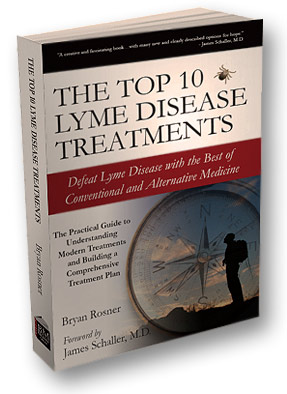|
ne of the unfortunate truths of current
treatment practices in tick-borne illness is the simple
reality that many patients do not fully recover. In my
practice, this occurs for many reasons, including such
culprits as indoor mold toxin exposure, patient genetic
limitations in the removal of Lyme Disease biotoxins, and,
quite often, undiagnosed new Babesia and Bartonella strains.
As a practicing physician, I have the
opportunity to observe firsthand the intricacies of Lyme
Disease and its co-infections. I have found that Borrelia
Burgdorferi is rarely the only active infection present. Ticks
pass on many infections which have the ability to quickly
reach all body cavities and tissues―from the brain to
the teeth and everywhere in between―and to release
surface biotoxins that dysregulate numerous hormones including
thyroid hormones, fertility hormones, testosterone, DHEA, and
leptin. The latter is usually too high and is associated with
treatment resistant obesity. These surface biotoxins hijack
many lesser known hormones, proteins, and inflammatory
chemicals, resulting in widespread pathology throughout body
systems and organs.
Additionally, my experience is that 99%
of Lyme Disease patients have psychiatric or subtle
neurological findings, which are often missed by sincere
health care workers. Clinical manifestations include diagnoses
as varied as depression, obsessive-compulsive disorder, rages,
schizophrenia, brain fog, memory loss, a profound decrease in
reasoning abilities, poor insight, panic attacks, agitation,
confusion, personality changes, mania, seizures, strokes, and
many more.
These are just a few of the many
obstacles facing modern health care practitioners who treat
Lyme Disease. As a result of these complexities in tick-borne
illness, eradicating Lyme Disease is virtually never simply a
matter of using high dose antibiotics for a month or a year.
Successful treatment is far more involved. I make these
comments because, in 2007, it is naive to think that all new,
important treatment information for Lyme Disease or its
co-infections will come from a few infectious disease
physicians or family doctors. We need an expanded approach,
one that encompasses a wide array of treatment methodologies
and options. The antibiotic-only approach, whether applied for
a short time or a long time, is simplistic.
Into this arena, Bryan Rosner offers an
exceptionally broad, important and clearly written book that
is sure to be a top medical resource for this decade. This
author is unusually gifted at clearly presenting newly
emerging treatments or revised treatments. This book allows
you to actually understand important and fascinating new
information without having to strain your brain.
The topics he has chosen are very broad
and relevant and offer easily understood lessons to both Lyme
Disease illness veterans and those new to this profound
disease. He offers hope in the context of a wide range of
options beyond merely expecting your physician to cure you in
once-a-month appointments largely limited to antibiotic
adjustments. Bryan Rosner thinks big. He offers big solutions.
He offers diverse and varied answers to the problem of chronic
Lyme Disease treatment.
He is also a big listener. He has been
listening to many of the top minds in innovative medicine and
has successfully prepared a fine, educational read that leaves
one satisfied and encouraged. He has tried very hard to study
deeply, and to be balanced and humble. Yet he offers
information any author would be proud to write.
Bryan Rosner is a passionate explorer
willing to sweat the extra miles. And to the good fortune of
Lyme Disease sufferers, he is not exploring space or the deep
oceans or foreign lands. Instead he is exploring breakthrough
treatments that offer hope to those suffering from this
devastating affliction. Wisely, each of his top 10
interventions stands alone, since he knows Lyme Disease is
never treated with a cookbook approach, but only with highly
individualized, closely supervised care.
Lastly, and most importantly, Bryan
Rosner is one of us. His passion to learn and heal the
suffering that he himself has defeated, is the passion of one
connected to those still left behind with incomplete healing.
He studies and writes with the zeal of one who cares for his
readers. His tone
is neither cold nor detached; instead, it is that of a friend.
To help you achieve a complete recovery,
he offers this exceptionally creative and fascinating book
with many new and clearly described options for hope.
James Schaller, M.D.
Author
of 16 books, including:
s
The Diagnosis and Treatment of Babesia
(buy this book)
s
Suboxone: A Revolutionary New Medication for Pain and Detoxification
s
The Use of Artemisinin for Cancer, Malaria and Babesiosis (buy
this book)
s
100 Commonly Missed Causes of ADD, Irritability and ODD in Children
s
Mold Illness and Mold Remediation Made Simple (buy
this book)
Author
of articles in 25 medical publications, including:
s
The Journal of the American Medical Association
s
Medscape
s
The Journal of Clinical Neurosciences
s
Journal of the American Society of Child and Adolescent Psychiatry
s
Internal Medicine News
s
Family Practice News
s
Townsend Journal
s
American Journal of Psychiatry
 |
The Top 10 Lyme Disease Treatments:
Defeat Lyme Disease With The Best Of Conventional And
Alternative Medicine
Paperback
367 Pages
$35
|
|